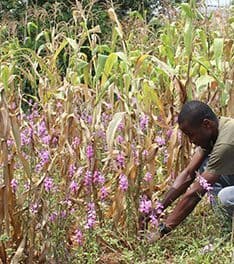Over one per cent of flowering plants are parasitic and extract food and water from other plants. They have a profound effect on both natural and agricultural systems. They include evolutionary enigmas, for example plants that grow inside other plants, and ecosystem engineers, for example hemiparasites that regulate biodiversity in plant communities. Parasitic plants are also a powerful public engagement mechanic at a time when fostering care and attention for plants has never been more urgent.
As weeds, some parasitic plants have a significant impact on the health, wellbeing, and livelihoods of people around the world. The genera Striga (witchweeds), Orobanche and Phelipanche (broomrapes) in the family Orobanchaceae, are some of the most destructive weeds globally. These parasites infect over 50 million hectares of arable land in sub-Saharan Africa resulting in annual losses of more than US$10 billion. This dire situation will be made worse by the effects of climate change and requires urgent solutions. Emerging research now provides insights that will enable strategies for controlling parasitic weeds using cross-disciplinary approaches.
This special issue will highlight current research on parasitic plants following the 16th World Congress on Parasitic Plants held in Nairobi, Kenya between July 3 and July 8, 2022.
Interdisciplinary approaches to examining the evolutionary ecology of parasitic plants, and addressing the challenges associated with parasitic weeds and their impact on people, society and the wider world are all encouraged. Submissions are welcome on a broad range of research topics, including but not exclusively:
- Host resistance and virulence: Underpinnings of host resistance against parasitic plants, association mapping of resistance against parasitic plants. Papers explaining virulence of parasitic plants are also encouraged.
- Genes and genomes: Including gene expression analysis, and genome sequencing and how this enhances mechanistic understanding of plant-parasite interactions and of evolutionary relationships of parasitic plants.
- Molecules and biochemistry: Rhizospheric communication between parasitic plants and hosts including molecular stimulation and inhibition of parasite seed germination, control strategies using hormones and other molecules.
- Parasitic plant biology and ecology: Growth and development of parasitic plants including haustoria structures, ecological aspects of parasitic plants such as distribution range, hyperspectral imaging and emerging threats by parasitic plants. Other areas include interactions of parasitic plants with microbes and fauna such as pollinators.
- Phylogeny and evolution of parasitic plants: Evolution of parasitic plants and phylogenetic relationships, adaptation of parasitic plants by leveraging genomics as well as aspects of host-specific selection by parasitic plants.
- Control and management of parasitic plants: All aspects of control and management of parasitic plants using cross-disciplinary approaches.
- Economic impact and policy: Economic aspects of parasitic plants, global policies on diversity, conservation and utilisation of parasitic plants.
To ensure special issue manuscripts meet the aims and scope of Plants, People, Planet, submissions should be placed in the wider context of their relevance to people, society and the planet, including any implications for policy and / or practice. These themes should also be highlighted in a 100 word Societal Impact Statement to accompany submissions (please see the submission guidelines below for details).
Please submit your manuscript by February, 28, 2023. Please contact the editorial office if you have any questions, or a potential manuscript that you would like to discuss. See here for more information.
With best wishes,
Steven Runo, Susann Wicke, Tadao Asami and Chris Thorogood
